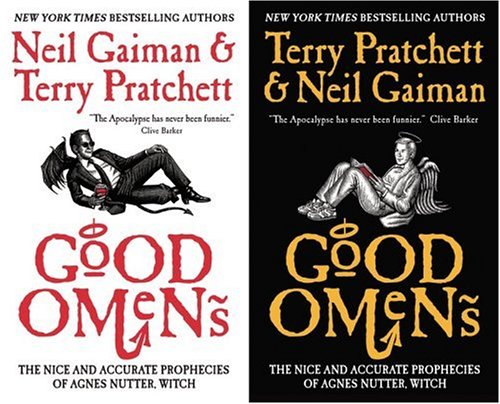By Claire Frank
It is fairly evident that people are pretty obsessed with the end of the world: how it’s going to end, when it’s going to happen, etc. Well, the “end” of the world (at least according to the Mayan calendar) has come and gone, yet these apocalyptic tales remain extremely popular, with a whole slew of countless films, TV shows, and books continuing to be chugged out for public consumption. However, it’s going to be awhile before these come out, so why not try something a little less recent?
Good Omens by Neil Gaiman and Terry Pratchett is a highly satirical rendition of humanity’s judgment day that literally makes readers laugh out loud. The story follows friends Aziraphale the angel and Crowley the demon as they scramble to stop the hosts of Heaven and Hell, Adam Young (the Antichrist), and the upcoming apocalypse. Featuring a large variety of comical characters, the highly sarcastic humor and lighthearted tone so uncommon with apocalyptic tales provided by Gaiman and Pratchett offers something for just about everyone.
I read this book as a digital copy using an e-reader: DO NOT MAKE THIS SAME MISTAKE. The formatting of the book doesn’t really work well in a digital form and while it’s not unreadable, it takes away from the overall experience.
Often considered a cult classic (not in a negative way), Good Omens has a small following of extremely loyal fans; and for good reason. The book is written extremely well with clear influence from Douglas Adams, especially his Hitchhiker’s Guide to the Galaxy. There are clear parallels in the style, format, and overall tone.The continuity is quite possibly the best I have ever seen, bringing back jokes that often cause more than an appreciative chuckle. It stands up to a re-reading, as this allows the reader to fully comprehend the extensive foreshadowing used by Gaiman and Pratchett.
One of my favorite parts of the book, besides the humor, is that Gaiman and Pratchett do a fantastic job of breaking stereotypes and portraying neither side as purely good or evil. They take these religious entities that have historically been perceived in a very black-and-white manner and show the gray space in between. Angels aren’t purely good and demons aren’t purely evil. The Antichrist is actually a really sweet kid who doesn’t truly want the end of days; not all nuns are as saintly as they seem (although they’re still really kind and sweet). Many readers sympathize with Crowley, a character expected to be sinister and cruel, and do not necessarily think of him as evil. Aziraphale is not depicted as this emotionless symbol of all that is good in the world as many writers tend to portray angels, but rather as a humble, somewhat bumbling character. They take the theme of free will to show that not everything is set in stone and it’s okay to go against the seemingly ineffable plan.
A negative to the story, at least from an American perspective, is that this book is meant for the British. The story is written by two British authors, was published in Britain, and is set in Britain. Therefore, it is can be expected that much of the humor is geared towards a British audience and will leave American readers slightly confused and often unaware of the joke. The book, however, contains so many jokes that everyone will understand that this doesn’t really take away from the overall experience. While American readers may feel briefly left out at points, this feeling quickly passes.
While the story heavily features Christian theology, it should not be considered a religious book. You don’t have to be Christian to understand the story; if anything, secular readers would probably enjoy it more than the religious because they are less likely to be offended, though this isn’t a wholly offensive book. While certain aspects may seem a bit mocking to the devout, you have to remember that this is a comical work and nothing is meant to be serious. If you’re easily offended then you should probably avoid this novel, but if you understand and appreciate sarcasm, I would definitely recommend it.






